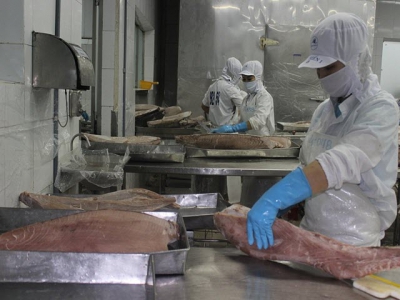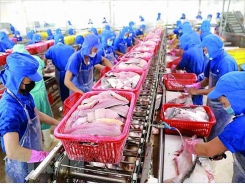The growth of seafood exports depends on removing the yellow card

If Vietnam removes the IUU "yellow card", seafood exporters will take advantage of tariff incentives and institutional changes from the EVFTA, recovery opportunities and the goal of increasing seafood exports to the EU market to US$1.2-1.4 billion in the coming years is feasible.
Tuna exports to the EU were deeply affected. Photo: T.H
Imported seafood materials increased
On October 23, 2021, four years after Vietnam's seafood was given the IUU "yellow card" by the European Commission (EC), the Vietnam Association of Seafood Exporters and Producers (VASEP) held a conference to evaluate the implementation of the yellow card removal of seafood enterprises.
At the conference, giving a picture of seafood exports from 2016 to 2021, Le Hang, Deputy Director of VASEP.PRO, said that seafood export growth in 2017 was nearly 18%, but gradually decreased in the following years.
For seafood, the negative growth has been increasing since 2018, from two markets in 2017 to four markets in 2018. Until now, only the US market has grown positively. Tuna accounted for 23% of total seafood exports in 2017, so far, the proportion is only 18%.
Notably, raw materials for seafood imports increased year by year, from US$731 million in 2016, to US$1.4 billion in 2020 and US$1.2 billion in the first nine months of 2021. In which, the import and export processing products with the highest increase are tuna and octopus.
According to experts, seafood exports are positive, but the source of imports is also large. This showed difficulties in the source of raw materials for seafood processing and export of Vietnamese enterprises.
The growth rate of seafood exports to the EU from 2017-2021 has gradually decreased. To increase exports, enterprises must be proactive in their processing materials. For example, clam products are not imported, not included in the IUU, businesses have been proactive in domestic raw materials, so they still maintain a high export growth rate, with nearly 60% in the first nine months of 2021.
According to VASEP's forecast, in October 2021, seafood exports will continuously decrease compared to the same period in 2020, with a decrease of 20-25%. Seafood exports for the whole year will strive to reach the 2020 level of US$8.4 billion.
Enterprises and management agencies have affirmed that if Vietnam removes the IUU yellow card, seafood and export enterprises would take advantage of tariff incentives and institutional changes from the EVFTA, recovery opportunities and the goal of increasing seafood exports to the EU market to US$1.2-1.4 billion in the coming years would be feasible.
Strictly handle violating fishing vessels
After four years of working to remove the IUU yellow card, Nguyen Hoai Nam, Deputy Secretary General of VASEP, said nearly 100 seafood processing factories have committed to use legally exploited processing materials, especially tuna processing and exporting enterprises; install cruise monitoring equipment on fishing vessels with a length of 15 meters or more with signals on the cruise monitoring system for more than 27,000 units.
With the participation of the Government, ministries and branches, the efforts of seafood enterprises, the Management Board of fishing ports, and fishermen, after nearly four years of implementation, the EC highly appreciated and recognized Vietnam's commitment, political determination, and efforts in implementing solutions to combat IUU fishing.
The EC also affirmed that Vietnam has made progress and is on the right track; recognized and highly appreciated Vietnam's goodwill, cooperative spirit, transparency and honesty in providing and exchanging information between the two sides on the results of the implementation of combating IUU fishing.
Phan Thi Hue, Director of the Legal Inspection Department, General Department of Fisheries, said that since the “yellow card” was issued, the EC has organized two visits to Vietnam in May 2018 and November 2019, and two online discussions in 2020.
Through the above inspections, the EC highly appreciated Vietnam's goodwill and cooperation, providing transparent and honest information; the legal framework is completed in a timely manner. The implementation of regulations on anti-IUU fishing has been better than before. Specifically, the installation of cruise monitoring equipment on fishing vessels and marking fishing vessels has made remarkable progress.
According to the latest EC assessment, Vietnam has completed a good legal framework, but law enforcement is weak because the number of fishing vessels violating IUU fishing regulations has been high. In 2020, the management agencies sanctioned 2,700 cases; from the beginning of 2021 up to now, there have been 1,500 violating fishing boats handled.
Colonel Nguyen Dinh Phuc, representative of the Coast Guard Command, said that some fishermen did not follow the law. Even fishermen who intend to illegally exploit seafood in foreign waters attacked the Coast Guard when warned and prevented. "In this case, we will consolidate the file, consider prosecuting to deal with it seriously," said Phuc.
Hue said that it is necessary to overcome limitations in the chain of seafood production and processing from state management agencies to businesses and people. In which, business is the most important link. On October 27, the EC will continue to check Vietnam's yellow card remediation through an online form.
Currently, relevant units are continuing to overcome the restrictions recommended by the EC, striving to remove the yellow card in 2022 in accordance with the direction of the Prime Minister.
"On October 23, 2017, the EC warned of a "yellow card" for IUU fishing and made nine recommendations that Vietnam should take to combat IUU fishing, and removing the "yellow card". The EU is an important partner for Vietnam's seafood exports, with a very high growth rate.
However, in the last four years, seafood exports have dropped deeply from US$1.5 billion in 2017, down to US$1.3 billion in 2020. If the "yellow card" is not removed, in the event of a "red card" by the EC, the most immediate and direct impact on Vietnamese seafood will be the EC's trade ban. At that time, it is estimated that Vietnam's seafood industry will lose about US$480 million per year if the EU market is lost; seafood output will be reduced by about 30%," said Nguyen Thi Thu Sac, Vice President of VASEP, Chairwoman of the Seafood Committee.
Có thể bạn quan tâm
Phần mềm

Phối trộn thức ăn chăn nuôi

Pha dung dịch thủy canh

Định mức cho tôm ăn

Phối trộn phân bón NPK

Xác định tỷ lệ tôm sống

Chuyển đổi đơn vị phân bón

Xác định công suất sục khí

Chuyển đổi đơn vị tôm

Tính diện tích nhà kính

Tính thể tích ao hồ




 Vietnam pangasius accounts for 93% of catfish imports…
Vietnam pangasius accounts for 93% of catfish imports…  Seafood exports - Expectations from key commodities
Seafood exports - Expectations from key commodities